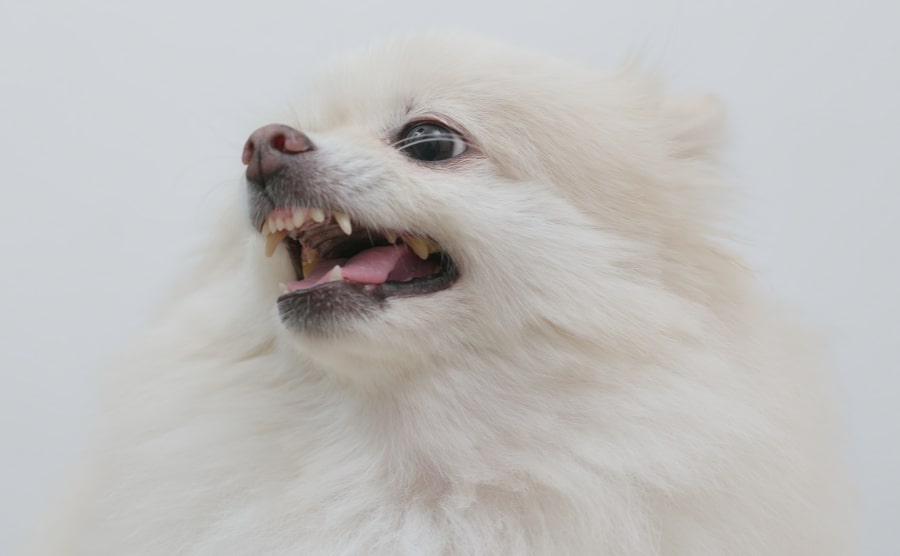Are you wondering what to do about Pomeranian teeth decay? You might be if you notice that your Pomeranian has a hole in their tooth. Left untreated, your Pom might lose one or more of their pearly whites.
So, what can you do with Pomeranian teeth decay? In the early stages of tooth decay, your vet might be able to clean the tooth and fill the cavity. In advanced stages, vets do a root canal to seal the tooth or remove the decayed tooth completely.
So, how can you tell that your Pomeranian has tooth decay and how to prevent it? Keep on reading to find out.
Why Do Pomeranians Develop Tooth Decay?
While some dog breeds enjoy good oral health, Pomeranians aren’t one of them. In fact, Poms often have teeth problems and suffer from periodontal disease. But why?
An adult Pomeranian has 42 teeth in their mouth. Due to the small size of the mouth, plaque accumulates easily above and below the gum line. Food also gets trapped between the teeth and allows bacteria to multiply rapidly.
In time, plaque hardens into tartar, and tartar irritates the gums and causes gum inflammation. That’s how periodontal disease begins in Pomeranians.
Dental disease is quite common in Pomeranians. Tooth decay, on the other hand, isn’t because of the cone shape of their teeth.
However, since Pomeranians are prone to plaque buildup, they’re more likely to develop tooth decay than other breeds. A diet high in carbohydrates, gaps between the teeth and gums, and poor overall health also contribute to tooth decay in Pomeranians.
When you don’t remove plaque regularly, bacteria produce acids that attack the enamel of the tooth and weaken it. Enamel protects the teeth from damage, and without the enamel, bacteria and white blood cells attack the tooth and digest it.
Besides plaque, retained puppy teeth are the other main reason for tooth decay in Pomeranians.
Most Pomeranians start teething around the time they’re 4 months old and should have their permanent adult teeth by the time they’re 8 months old.
However, sometimes this change doesn’t go as smoothly as you expect it to because the puppy tooth doesn’t fall.
So there isn’t enough space for the adult tooth to erupt normally, which leads to teeth overcrowding and misaligned bite patterns.
Teeth overcrowding is a major problem for a small dog such as Pomeranians. That’s because when your Pom’s teeth are too close to one another, they rub.
That’s not healthy for their teeth because it chips and wears the enamel. Once the enamel is damaged, the tooth is vulnerable to bacteria.
The bad news is that you can’t restore enamel once it’s gone. That’s why it’s so important to deal with any retained Pomeranian teeth as soon as possible. Usually, your vet will remove these teeth surgically to allow the adult teeth to erupt normally.
What Are the Signs of Tooth Decay in Pomeranians?
To know what to do with Pomeranian tooth decay, you have to learn the signs of tooth decay so that you can take measures. Unfortunately, it’s easy to miss the initial signs of Pomeranian teeth decay.
1. Visible Holes in the Teeth
When you examine your Pom’s teeth, you might notice small holes in them or dull spots on the surface of the teeth. That’s tooth decay.
Sadly, cavities are not that easy to spot in Pomeranians. Sometimes these holes are small and form close to the gum line. So they remain unseen for quite a while.
Don’t let the small size of the hole mislead you that the problem isn’t serious. Usually, the cavity looks small on the outside, but it’s quite big on the inside.
Form a habit to check the first molars on top and bottom, because they’re the most likely teeth to develop caries due to their deep grooves.
2. Bad Breath
Pomeranian owners often think that it’s normal for their Poms to have stinky breath. Let me tell you something. It’s never normal for your Pom’s breath to smell like garbage.
Usually, bad breath is one of the first signs of periodontal disease and shows you that you’re neglecting your Pom’s teeth.
3. Toothache
Your Pom can’t tell you that their tooth is hurting. But drooling more than usual or favoring one side of the mouth when chewing indicate tooth pain or gum inflammation.
Moreover, your Pomeranian might shy away from your touch whenever you try to pet them around the mouth.
4. Lack of Appetite
Once your Pom’s tooth starts hurting, you’re going to notice some changes in their eating habits.
For example, some Poms might be reluctant to eat and whine or whimper while chewing. Others might stop eating in the middle of their meal or spit out their food.
How to Prevent Pomeranian Teeth Decay?
Pomeranian teeth decay is difficult to treat, especially if the whole tooth has been damaged. Your vet will have to extract the decayed tooth to prevent caries from spreading.
As such, it’s better to prevent this condition than to wonder what to do with Pomeranian teeth decay.
1. Brush Your Pomeranian’s Teeth
When it comes to Pomeranians, plaque forms in a day. Then it hardens into tartar for about two days.
Once that happens, you won’t be able to remove the tartar no matter how much you brush your Pom’s teeth. Your vet will have to do a professional dental cleaning to get rid of it.
To remove plaque and ensure the health of your Pom’s teeth, you should brush their teeth at least thrice a week with a suitable toothbrush and toothpaste. Brushing regularly also ensures that you’ll notice any potential problems on time.
2. Get Dental Chews and Water Additives
Another way to prevent Pomeranian tooth decay is to use dental chews. These treats are made to scrape the plaque from your Pom’s teeth when your Pomeranian chews on them.
In addition to dental chews, there are food and water additives that make your Pom’s saliva more hostile to bacteria. These additives also improve your Pom’s oral health by breaking up plaque.
3. Consider Oral Care Food
You should always feed your Pomeranian a high-quality dog food. Poor diet and food high in carbohydrates increase your Pom’s chances of getting tooth decay.
In addition to this, you can get oral care food for your Pomeranian. Just like dental chews, it’s made to reduce the plaque buildup inside the mouth and improve your Pom’s oral health.
Look for the Veterinary Oral Health Council’s stamp of approval when you’re choosing a brand.
What Are the Consequences of Untreated Tooth Decay?
Pomeranian teeth decay isn’t only dangerous because your Pom might lose a tooth or two. Bacteria damages not only the teeth but also the surrounding tissue. So, one of the possible consequences is a weak jaw, which can shatter under the slightest pressure.
Another danger is that bacteria might enter the bloodstream. From there, it will travel to all the major organs and wreak havoc. Dental disease is often linked to kidney failure, liver disease, and congestive heart failure.
Last but not least, decaying teeth lead to weight loss because Pomeranians are reluctant to eat due to toothache. This weakens your Pomeranian’s organism because your Pom isn’t getting all the nutrients they need to thrive.
Closing Thoughts
Pomeranian tooth decay is an urgent problem, and it can be difficult and costly to treat. As such, you have to take good care of your Pomeranian’s teeth to prevent plaque from building up and keep an eye for retained puppy teeth. Otherwise, you’re compromising your Pom’s overall health.





